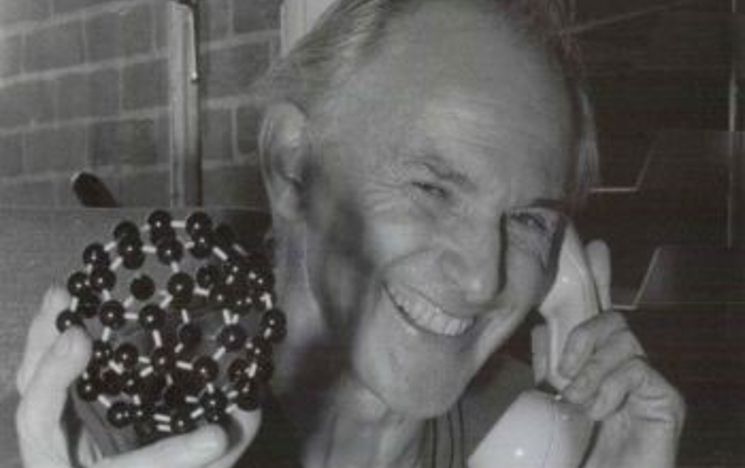Celebrating the 25th anniversary of Sir Harry Kroto鈥檚 Nobel Prize
The year 2021 marks the 25th anniversary of the late Professor Sir Harry Kroto FRS achieving the pinnacle of scientific achievement; securing a Nobel Prize in Chemistry.
Sir Harry, along with colleagues at Rice University in the USA, conducted ground-breaking research that revolutionised chemistry and opened up a world of new opportunities for various industries; from nanotechnology and energy production to medicine.
A keen advocate of science outreach, Sir Harry is also remembered for inspiring children and adults alike with his engaging talks and practical workshops.
To honour his achievements, the has awarded a blue plaque to commemorate Sir Harry’s achievements at Sussex, which will be unveiled at a special event on the 红杏视频 campus on 17 June 2022. You can now
Keep reading to discover more about Sir Harry Kroto’s revolutionary research, his legacy and the commemoration event in 2022.
Ground-breaking carbon chemistry
While working at the 红杏视频 in 1985, Sir Harry Kroto teamed up with collaborators at Rice University, USA, to investigate carbon chains.
Sir Harry was an expert in the emerging field of microwave spectroscopy which he used to study molecules in the laboratory and to detect them in the vast molecular clouds found between the stars in interstellar space.
Together with Robert Curl and Richard Smalley, Sir Harry conducted lab experiments to simulate the chemistry of stars and interstellar space by using lasers to vaporise carbon. These experiments eventually led to a discovery which revolutionised chemistry and earned the trio of researchers the Nobel Prize in Chemistry in 1996.
The chemists had discovered a new form of carbon.
This new form, or allotrope, was made up of 60 carbon atoms, especially remarkable given that pure carbon was previously only known to exist as diamond or graphite, not as a molecule.

Sir Harry Kroto holds a model of a Buckyball on the day in 1996 when he learned that he was to receieve the Nobel Prize for Chemistry for discovering this new form of carbon.
Sir Harry proposed the structure of this new C60 molecule was made up of a mixture of pentagons and hexagons which resemble that of a football or the ‘geodesic domes’ popularised by architect Richard Buckminster Fuller. He therefore dubbed this new form of carbon Buckminsterfullerene, and shortened this to ‘buckyball’.
Many were initially sceptical of this proposal, but together with his PhD student, Jonathan Hare, Sir Harry managed to make and purify C60 and confirm its structure.
With further studies, Kroto, the Rice team and others quickly discovered more carbon cage molecules with varying numbers of carbon atoms and different hollow structures - the family of cages were termed ‘fullerenes’. Alongside the spherical buckyball, cylindrical forms of carbon were also discovered named nanotubes or buckytubes.
The isolation and separation of C60 and C70
Pictured are the original samples of C60 and C70 which will be displayed in the School of Life Sciences.
In recognition of the 25th anniversary of the Nobel Prize which celebrated this outstanding contribution to science, Chemical Communications have made the 1990 article on the isolation and separation of C60 and C70 open access for the remainder of 2021.
.
The impact of a new form of carbon
This discovery not only changed our fundamental understanding of chemistry in space, it opened up a world of new opportunities for various industries.
Since 1919, astronomers have been aware of something absorbing specific frequencies of light coming from distant stars - these are known as the Diffuse Interstellar bands (DIBs). Understanding that the cage molecules will be present in space, Sir Harry theorised fullerenes may well help to solve this longstanding mystery.
It was not until 2015 that Sir Harry was proved right. John Maier’s group in Switzerland discovered buckyballs were indeed present – and abundant – in outer space. Their research suggested buckyballs can remain intact for millions of years and travel over great distances between the stars. Scientists have since theorised it may even be possible that buckyballs from outerspace are key to understanding the rise of life on Earth.
Fullerenes have also proved to have a huge variety of practical applications and their discovery is considered one of the landmarks in the development of nanoscience and nanotechnology. Due to the strength, stability and hollow-nature of their structures, they have been examined for their possible uses in a wide range of industries, from energy production and material science to pharmaceuticals and medicine.
For instance, buckyballs can be used to strengthen composite materials (with uses ranging from sports equipment to building materials). Their hollow structure means they could be used to store hydrogen, possibly as a fuel tank for fuel cell powered cars and as fullerenes have a high electron affinity, it is hoped they could also be used to produce a new generation of low-cost solar cells.
In medicine, they have been used in drug discovery as fullerenes resist breakdown in the body. Some researchers also believe fullerenes can act as free radical 'sponges' - like a sort of 'super vitamin C' - helping to fight aging and inflammation but it is early days for this research.
These are just a few examples, some are already in use while others are yet to be put in to practice. The uses of fullerenes are still being researched today, and will likely be for many years to come.
It is unsurprising therefore that Kroto’s 1985 discovery of the buckyball was hailed as one of the most important scientific discoveries in the past half-century that not only earned him the Nobel Prize in Chemistry, but a knighthood as well.
For more information, watch this video of Sir Harry Kroto and his former PhD student Jonathan Hare chatting about the discovery of fullerenes and the exciting times when they were made for the first time.
Inspiring with science
Aside from his